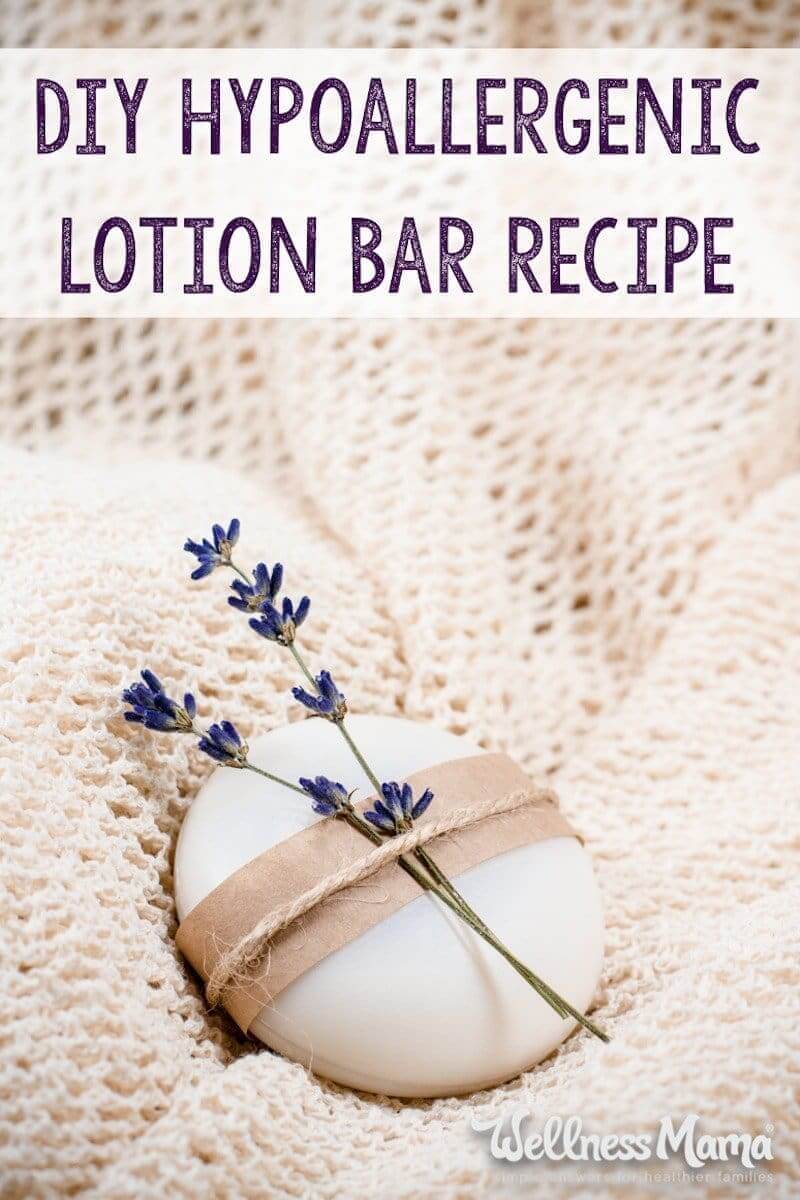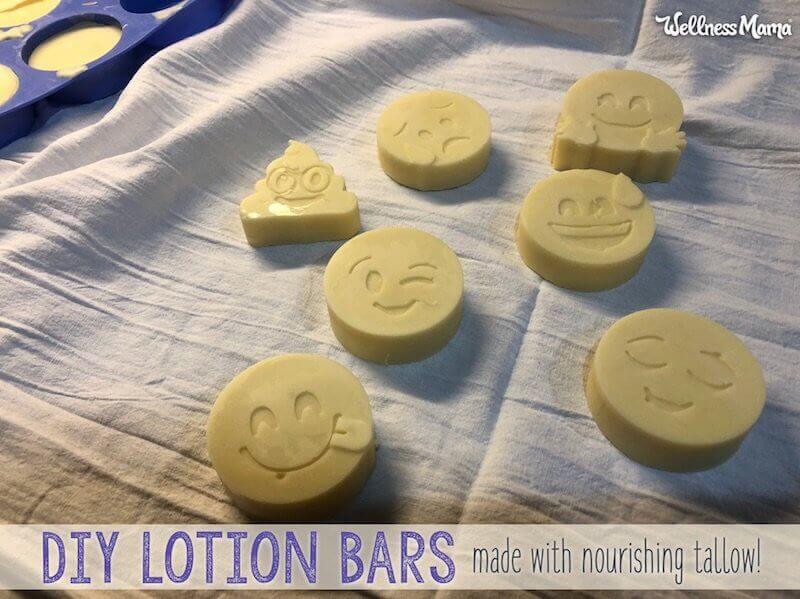We use lotion bars all the time at our house.
The concept is great — a bar that looks like soap but that you use on dry skin like lotion. I’ve even customized them to make sunscreen lotion bars, bug off lotion bars, and pain relief lotion bars.
All of those recipes are natural and safe even for sensitive skin and babies (though I omit the essential oils for use on babies and children), but I’ve had several readers ask about what to do if they couldn’t use coconut oil due to an allergy. After some experimentation, I figured out how to make a more hypoallergenic lotion bar recipe that is our new favorite and that is excellent for any skin issues.
It uses a surprising ingredient… tallow!
Why Tallow?
Tallow is essentially fat rendered from beef. Sounds weird to use beef fat in a beauty recipe, but it can be beneficial to skin and has a long history of use. As my favorite bone broth company explains:
As a saturated animal fat, tallow almost looks like a hybrid of coconut oil and butter, but with a dry, waxy texture. It’s generally made from cattle fat, but can come from any animal, except pork — pork tallow is called lard. So, tallow is basically cow lard.
Beef tallow is: 50% saturated fat, 42% monounsaturated fat and 4% polyunsaturated fat.
The structure of our cell membranes is made up of approximately 50% saturated fats, which is very similar to the percentage of saturated fatty acids in tallow. Fatty acids are also the building blocks of healthy skin cells, which makes them an important nutrient for skin repair and regeneration.
This is a similar composition to our skin, which makes tallow a beneficial (albeit unlikely) skincare ingredient. Tallow also contains fat-soluble vitamins like A, D, E, and K, which offer additional benefits to the skin. For similar reasons, other animal fats like duck fat, hump fat (from camels), and even lard have historically been used in skin care.
Of course, if you’re not a fan of using animal products on your skin, you can use any plant-based oil or fat in equal parts instead. Try mango butter, shea butter, cocoa butter, or coconut oil.
Tallow on Skin: What I Noticed
I admit that I was a little apprehensive about using tallow on my skin at first, but loved the way it made my skin feel. It is amazing how silky it makes skin and it is really effective at soothing minor skin irritation.
I’ve also found (probably due to the natural SPF in the shea butter and the fat-soluble vitamins in the tallow) that these lotion bars are an excellent mild skin protector for short-term sun exposure. They seem to help the skin tan without any redness (this coming from an Irish girl).
Tallow lotion bars also seem to really help skin healing. They have worked wonders on my son’s eczema scars and a scratch on one child’s face (a gift from a sibling). Overall, I think that tallow-based skincare products are a great alternative to coconut-based products for those who are allergic and they don’t seem to have the same pore-clogging properties that some people experience from coconut.
How to Make Hypoallergenic Lotion Bars
This recipe only takes about 15 minutes to make!
Ingredients
- 1/3 cup beef tallow from a healthy source (I get mine here). You can also render your own.
- 1/3 cup shea butter, cocoa butter, or mango butter
- 2 TBSP beeswax (can add an extra ounce or two if you want a thicker consistency, which leaves less lotion on the skin when used)
- 20+ drops of essential oils of choice (note: some, like citrus oils, will increase skin sensitivity). These are optional and make sure to only use skin-safe oils in proper dilution ratios.
Instructions
- Combine all ingredients in the top part of a double boiler over a small amount of water.
- Turn the burner on and bring water to a low simmer. Stir ingredients constantly until they are melted and smooth.
- Remove from heat and stir in the essential oils.
- Transfer to molds to harden. These are the cute emoji molds I used. Allow the lotion bars to cool completely before attempting to pop out of molds.
How to Use Tallow Lotion Bars
Store in a cool or dry place for up to six months (I’ve even had some last as long as a year).
To apply to skin: hold bar in hand and carefully rub on dry skin. The heat of the skin will transfer some of the lotion bar to the skin. I store my lotion bars on a small plate on my dresser and bathroom counter.
Don’t Want to Make Them?
If you want to use lotion bars but don’t have the time/ingredients to make them yourself, I found a great small business, Made On, that makes all kinds of lotion bars, soaps, natural baby products and hair products that are up to my standards. Their website is HardLotion.com and they have agreed to give Wellness Mama readers a 15% discount on all orders with the code “wellnessmama” at this link. (Note: Affiliate link… the price is discounted for you and I get a small commission to support my blog!)
Do you make lotion bars or purchase from the store? Ever used tallow as an ingredient in your skin care? Share below!



Leave a Reply